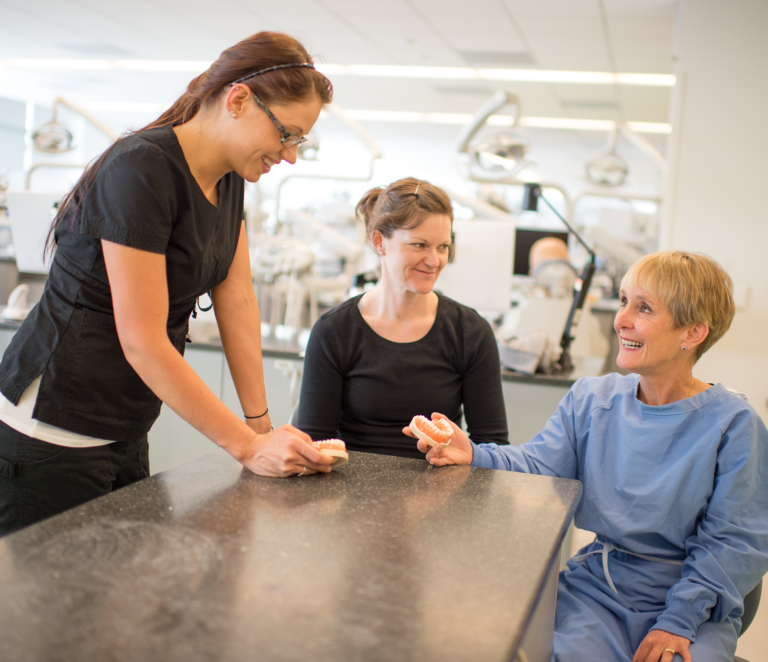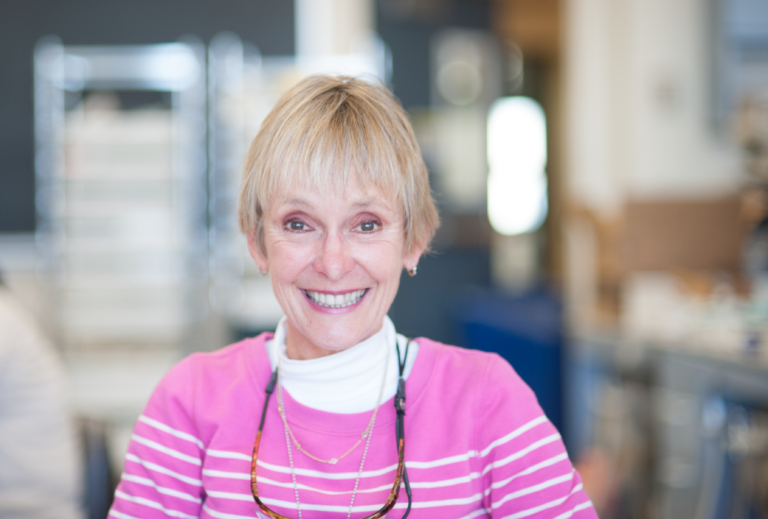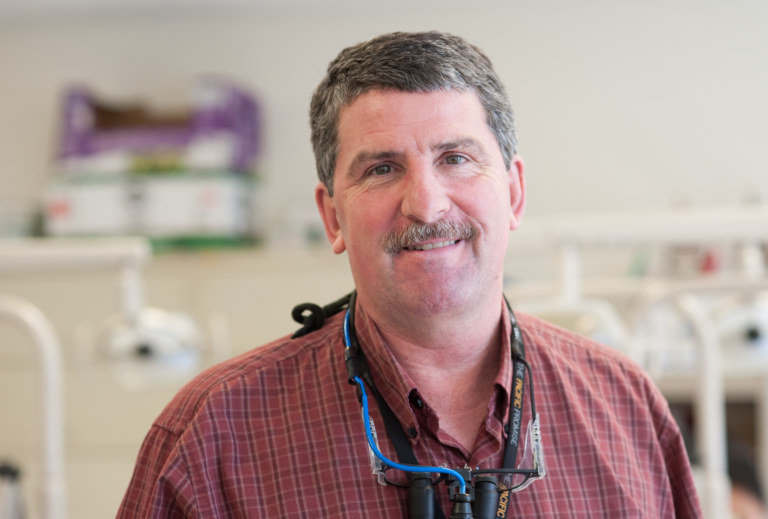By Christina Boufis
When her dentist at a busy cosmetic dental practice brought up the idea of enrolling in the RDAEF program at the Arthur A. Dugoni School of Dentistry, Leann Haas jumped at the chance. “I love dentistry and I love to continue learning. I was super excited,” says Haas, who enrolled in 2011 and graduated in 2012 as part of the first graduating class.
The Registered Dental Assistant in Extended Functions (RDAEF) program started at the Dugoni School of Dentistry in June 2011, explains Dr. Jane Wright-Hayes, director of the Division of Continuing Dental Education. It was the brainchild of Dr. Molly P. Newlon ’82, course director, who was involved in a smaller program at University of California, San Francisco, for many years. “But when they decided to drop it,” says Wright-Hayes, “she wondered whether we wanted to pick it up and do it here.” The answer was yes.
The application process to the Dental Board of California was extensive, says Wright-Hayes. “It took about a year to get approved,” says Newlon. And the Dugoni School of Dentistry is one of only two Dental Board of California-approved providers of the RDAEF program in Northern California.
“About seven years ago, the dental board approved the type of functions that an RDAEF would be licensed to do,” explains Newlon. “So, I created the course from scratch, and it went from about 11 days (at UCSF) to 45 days (at Pacific)—quite a bit bigger.”
The 410-hour course begins in August and runs until May, about 22 weekends. It meets for eight hours on several Saturdays and Sundays, says Newlon. “It’s a lot of work for everybody. In given treatment areas, the RDAs receive the same training that our dental students do,” she adds.
What does an RDAEF student learn? Placing and finishing permanent direct restorations, such as amalgams and composites; making impressions for tooth-borne removable partial dentures; fitting and cementing endodontic master points and accessory points for root canals; cord packing and final impressions for crown and bridge; and doing oral health assessments in community dental settings are some of the major categories, says Newlon.
“It’s hundreds of hours of lectures, hundreds of hours in the simulation lab working on the manikins. It’s pretty extensive. The students learn a lot,” says Dr. Brian Kenyon, associate professor in the Department of Dental Practice and a group practice leader in the student dental clinic, who teaches in the RDAEF program.
In addition to the didactic and extensive lab work, “Students are required to complete 20 restorations in a dental office where they work on patients under the direct supervision of their dentist,” explains Newlon. At the end of the program, students can take an exam administered by the Dental Board of California, and, if they pass, “then they’re licensed EFs and able to complete those functions in a dental office under the direct supervision of a dentist,” says Newlon.
“It was a whole year of my weekends,” says Denny Pham, RDAEF Class of 2013, who works at the Marin County Dental Service’s Community Clinic, serving a low-income population. “But I looked forward to going to the dental school and learning new things. I was very lucky,” he added. “I learned from Dr. Kenyon and Dr. Newlon—the best instructors. They taught me lots of things that I applied to my job very easily.”
For Kenyon, the feeling of excitement is mutual. “I think it’s a great program. I really enjoy teaching in it. I love teaching in general, but the dental assistants are so eager to learn, and they are just a pleasure to work with. It’s really rewarding for me.”
[pullquote]“I wouldn’t even call it work because I love dentistry, and they made the experience so positive. — Leann Haas[/pullquote]
Leann Haas calls the program a “life changing experience.” But, she adds, “I wouldn’t even call it work because I love dentistry, and they made the experience so positive. I looked forward to going on the weekends,” says Haas. “You’re there for eight hours a day, which went by so fast. You’re constantly learning, and I didn’t feel like it was work at all.”
One challenge that students face is monetary. “It’s expensive to take the program, so many students are asking their dentists to help them through,” explains Wright-Hayes. “What is heartwarming is that more and more dentists are stepping forward and saying, ‘I value my team members so much, and this is such a benefit not only to me but also to them.’ Some dentists even pay the entire tuition for their dental assistants.”
Dr. Mark Harris, who’s had a private practice in Eureka, California, for almost 42 years, did exactly that with two of his dental assistants, one who recently completed the program and another who is just starting this year. Both of his dental assistants had worked for him for decades, and it was he who first proposed the idea. “You would have these valuable skills and increase your earning potential with just going to school for one year,” he recalls telling his assistants.
[pullquote]“They love what they’re doing.” — Dr. Brian Kenyon[/pullquote]
What did his dental assistant gain from the program? “She had really good skills and a good knowledge of dentistry going into this, so it wasn’t difficult for her,” explains Harris. “But she gained knowledge about how to handle materials you use to restore teeth and got a better understanding of what her eye needed to see to be able to construct a restoration for a tooth. Your hands can’t do what your mind doesn’t know,” he adds.
Now that his first dental assistant has successfully completed the program, Harris says it makes his work life easier. “I don’t have to do the fillings that I used to have to place after I’ve prepared the tooth to receive them,” he explains. “Once you’ve done your first 10,000 fillings, you know how to do it, you’ve done it. But that’s not one of the easy aspects of dentistry.”
Once his assistant enrolled in the program, some of their roles were reversed, recalls Dr. Harris. “We were working a lot of the time with me being the dental assistant and her being the operator. I’d be right there watching her place the fillings and helping her with instrumentation. To have somebody that gets to the skill level where you trust that they can pull that off and do it properly, that becomes a big load off the dentist’s back. Not only does it lessen the intensity of what you do all day, but your efficiency goes up.”
Kenyon hears similar things from students who’ve gone through the RDAEF program. “They love what they’re doing,” he says. “It gives them an opportunity to do a lot more for the dentist. It gives the dentist an opportunity to be able to see more patients, and if there’s a shortage of dentists, it can allow a clinic to see more patients, so it’s a win-win for everyone.”
Just ask Dr. Michael Aaronson ’66, part-time director of clinical services at the Marin County Dental Service who estimates the clinic serves 50 to 60 patients a day, depending on emergencies. “We’re funded exclusively by the county as a safety-net service, and we take patients no one else will see,” he explains. Having Denny Pham successfully complete the RDAEF program has been a tremendous help at the clinic. “It’s a great benefit,” says Aaronson. “Denny’s able to do many of the tasks that previously were restricted to dentists. He’s able to finish many restorations, to adjust and fix and cement restorations. It frees up some of the other dentists to perform other tasks like oral surgeries. It’s been very valuable for us to have him, and we truly appreciate his ability and experience.”
[pullquote]“It adds to their professional growth.” — Dr. Molly Newlon[/pullquote]
For Haas the range of functions she’s now able to do has also expanded. “Now on top of the typical RDA license, I’m able to cement final crowns and veneers, finish composites and restorations. That allows my dentist extra time, so once she starts the procedure I’m able to take over while she’s able to do more productive procedures.”
In addition to freeing up her dentist, an added benefit is to serve as “almost an extra set of eyes for the dentist. You have a better understanding and knowledge of why things are done,” says Haas. “My dentist really appreciated all the new skills I’ve learned because I’m able to communicate things that I see on a tooth that she probably couldn’t see on her side of the patient.”
Harris echoes the sentiment about his dental assistants, saying that their level of observation has increased. “Instead of looking in the mouth and dental assisting, they’re now looking in the tooth to understand exactly what I’m doing and how I’m doing it.”
As for the graduates, many of them continue to keep in touch, touting the benefits of the RDAEF program. “They’re all so happy that they did it,” says Newlon. “It adds to their professional growth. They are more valued members of the dental team. They can work much more independently than they ever did before, and make more money.”
“If I could go back to school, I’d do it all over again,” says Haas. “The Dugoni School of Dentistry felt like it was a close-knit family, which was awesome. I didn’t even want to graduate.”
Newlon recalls what one graduate of the RDAEF program recently posted on her Facebook page. “Best decision I ever made.” For students and instructors alike, the RDAEF program at the Arthur A. Dugoni School of Dentistry earns an A+.
Christina Boufis, PhD, is a freelance health and medical writer from the East Bay.



Dr. Molly Newlon 
Dr. Brian Kenyon.
